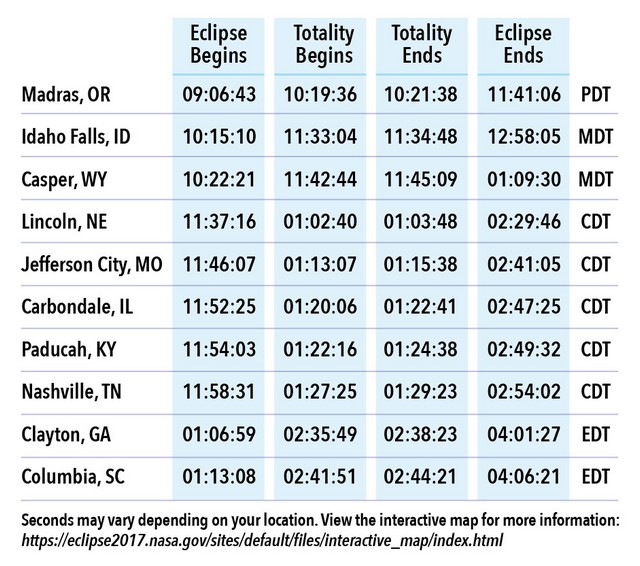Eclipse 101: Today’s Total Solar Eclipse 2017
Eclipse: Who? What? Where? When? and How?
On Monday, August 21, 2017, all of North America will be treated to an eclipse of the sun. Anyone within the path of totality can see one of nature’s most awe-inspiring sights - a total solar eclipse. This path, where the moon will completely cover the sun and the sun’s tenuous atmosphere - the corona - can be seen, will stretch from Lincoln Beach, Oregon to Charleston, South Carolina. Observers outside this path will still see a partial solar eclipse where the moon covers part of the sun’s disk.
Who Can See It?
Lots of people! Everyone in the contiguous United States, in fact, everyone in North America plus parts of South America, Africa, and Europe will see at least a partial solar eclipse, while the thin path of totality will pass through portions of 14 states.
What is It?
This celestial event is a solar eclipse in which the moon passes between the sun and Earth and blocks all or part of the sun for up to about three hours, from beginning to end, as viewed from a given location. For this eclipse, the longest period when the moon completely blocks the sun from any given location along the path will be about two minutes and 40 seconds. The last time the contiguous U.S. saw a total eclipse was in 1979.

Where Can You See It?
You can see a partial eclipse, where the moon covers only a part of the sun, anywhere in North America (see “Who can see it?”). To see a total eclipse, where the moon fully covers the sun for a short few minutes, you must be in the path of totality. The path of totality is a relatively thin ribbon, around 70 miles wide, that will cross the U.S. from West to East. The first point of contact will be at Lincoln Beach, Oregon at 9:05 a.m. PDT. Totality begins there at 10:16 a.m. PDT. Over the next hour and a half, it will cross through Oregon, Idaho, Wyoming, Montana, Nebraska, Iowa, Kansas, Missouri, Illinois, Kentucky, Tennessee, Georgia, and North and South Carolina. The total eclipse will end near Charleston, South Carolina at 2:48 p.m. EDT. From there the lunar shadow leaves the United States at 4:09 EDT. Its longest duration will be near Carbondale, Illinois, where the sun will be completely covered for two minutes and 40 seconds.
When Can You See It?
Times for partial and total phases of the eclipse vary depending on your location. This interactive eclipse map (link is external) will show you times for the partial and total eclipse anywhere in the world.
How Can You See It?
You never want to look directly at the sun without appropriate protection except during totality. That could severely hurt your eyes. However, there are many ways to safely view an eclipse of the sun including direct viewing – which requires some type of filtering device and indirect viewing where you project an image of the sun onto a screen. Both methods should produce clear images of the partial phase of an eclipse. Click here for eclipse viewing techniques and safety.
Additional Safety Information
An eclipse is a rare and striking phenomenon you won’t want to miss, but you must carefully follow safety procedures. Don’t let the requisite warnings scare you away from witnessing this singular spectacle! You can experience the eclipse safely, but it is vital that you protect your eyes at all times with the proper solar filters. No matter what recommended technique you use, do not stare continuously at the sun. Take breaks and give your eyes a rest! Do not use sunglasses: they don’t offer your eyes sufficient protection. The only acceptable glasses are safe viewers designed for looking at the sun and solar eclipses. One excellent resource on how to determine if your viewers are safe can be found here: https://eclipse.aas.org/eye-safety/iso-certification (link is external)
Viewing with Protection — Experts suggests that one widely available filter for safe solar viewing is welders glass of sufficiently high number. The only ones that are safe for direct viewing of the Sun with your eyes are those of Shade 12 or higher. These are much darker than the filters used for most kinds of welding. If you have an old welder’s helmet around the house and are thinking of using it to view the Sun, make sure you know the filter’s shade number. If it’s less than 12 (and it probably is), don’t even think about using it to look at the Sun. Many people find the Sun too bright even in a Shade 12 filter, and some find the Sun too dim in a Shade 14 filter — but Shade 13 filters are uncommon and can be hard to find. The AAS Reputable Vendors of Solar Filters & Viewers page (link is external) doesn’t list any suppliers of welder’s filters, only suppliers of special-purpose filters made for viewing the Sun.To find out more about eyewear and handheld viewers go to https://eclipse.aas.org/eye-safety/eyewear-viewers (link is external).
Telescopes with Solar Filters – Eclipses are best viewed directly when magnified, which means a telescope with a solar filter or solar telescopes. These will give you a magnified view that will clearly show the progress of an eclipse. Never look through a telescope without a solar filter on the large end of the scope. And never use small solar filters that attach to the eyepiece (as found in some older, cheaper telescopes.) https://eclipse.aas.org/eye-safety/optics-filters (link is external)
Pinhole and Related Projection Methods (link is external) — Pinhole projectors and other projection techniques are a safe, indirect viewing technique for observing an image of the sun. These provide a popular way for viewing solar eclipses. One viewing technique is to project an image of the sun onto a white surface with a projecting telescope. This is explained further here: http://www.astrosociety.org/education/publications/tnl/05/stars2.html (link is external)
The Exploratorium demonstrates how to view a planet in transit or an eclipse safely by projecting the image with binoculars: http://www.exploratorium.edu/transit/how.html (link is external). There are commercially available projection telescopes as well.
Besides eye protection during solar eclipse viewing, one needs to pay attention to their personal needs and surrounding. Below are some additional safety tips for eclipse observers before, during and after the August 21, 2022 solar eclipse.
Graphics-Only Solar Eclipse Safety Flyer
Car Safety
Planning to Drive the Eclipse (link is external)
https://www.ready.gov/car (link is external)
Camping Health and Safety
https://www.cdc.gov/family/camping/ (link is external)
http://www.recreation.gov/recFacilityActivitiesHomeAction.do?goto=camping.htm&activities=9 (link is external)
Heat and Children in Cars
http://www.safercar.gov/parents/InandAroundtheCar/heatstroke.htm (link is external)
http://www.safercar.gov/parents/InandAroundtheCar/heat-involved.html (link is external)
Federal Emergency Management Agency (link is external) – Are You Ready
Food and Water Safety (link is external)
Hazards to Outdoors Workers (link is external)
Heat and Hydration (link is external)
Hiking Safety (link is external)
Large Crowds Safety (link is external)
Personal Safety (link is external) – At Home, On the Street, While Traveling
Sun Safety: (link is external) Save Your Skin





